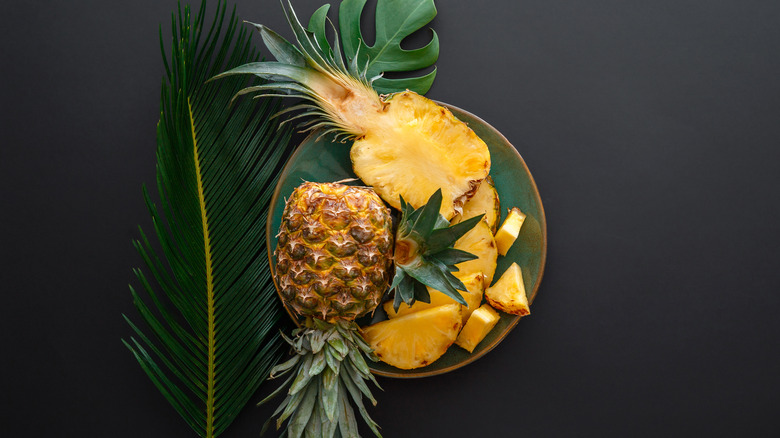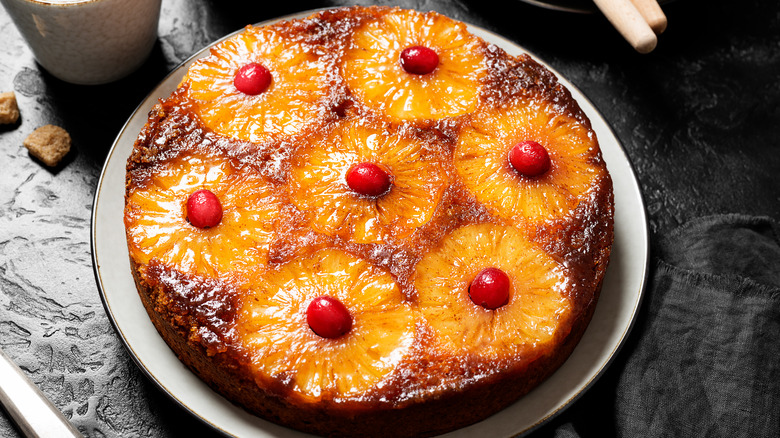Why Pineapples Used To Be So Expensive
They're bright, yellow, and tasty. Pineapples are one of the most popular fruits available in the United States, and for good reason. This fruit can be used in cocktails like a pineapple rum daiquiri, sandwiches, on pizza, or as a nice addition to a fruit salad. But beyond their flexibility, pineapples are plentiful, and usually not all that expensive. Perhaps best known for their canned form, pineapples are now a food of convenience. However, this wasn't always the case.
Pineapples used to be, well, a bit of a luxury item. In fact, during the 1700s, pineapples could sell for about $8,000 (in today's dollars), according to Mental Floss. The exorbitant price made the fruit the Birkin bag of produce, a true status symbol, with many wealthy Europeans shelling out ridiculous sums of money to get their hands on the perishable item.
For all of their luxury, pineapples were an icon of the colonial era. The fruit is believed to have originated in South America, around Paraguay and Argentina, and was cultivated throughout South America and the Caribbeans when Christopher Columbus brought them back to Spain from the Caribbean island of Guadeloupe in 1493. Over the next few centuries following Columbus' expeditions, Europe spread its colonial grip across the Caribbean and South America. As Europe expanded its claims over the so-called 'New World', the fruit became a highly sought-after item in Europe. Places such as England and the Netherlands, for example, cultivated the fruit in small quantities in specialized hothouses. However, the fruits remained incredibly rare, as shipping the produce across an ocean was difficult and often problematic. Because of this, the fruit became a luxury item in Europe and in North America.
A symbol of hospitality
Because of the pineapple's status as a luxury item, the fruit became a highly prized possession for those in Europe and the North American colonies. During the 17th and 18th centuries, the fruit actually became quite the party staple, often serving as a centerpiece at large gatherings. It was often displayed to indicate the host's high social standing. And for those who couldn't quite afford the exorbitant price of a pineapple to own, pineapples were often rented or loaned out to those in want of the festive fruit.
By the 18th century, pineapples began popping beyond the punch table, however. Southern Kitchen explains that the fruit began to appear in effigies on buildings, carved into columns and gateposts of luxurious estates. The origins of this practice are not entirely known, but it certainly plays to the fruit's status as a luxury item and is a natural aesthetic progression from the fruit's roots as a display of merriment and luxury. And, after all, a gate post carved in the shape of a pineapple lasts a lot longer than a passed-around party fruit. Some historians also tie the use of pineapple imagery in architecture to the Caribbean practice of hanging pineapples outside of villages.
Regardless of the origins of pineapple as a symbol of luxury and welcoming, the fruit has since become an icon in the hospitality industry, and for hosts and homemakers alike. The fruit can still be seen on gate posts, on welcome mats, and even on certain China patterns.
From luxury item to household staple
It's been a long time since pineapples were considered a luxury item. Canned pineapple is often considered a pantry staple , prized for its low price point and convenience. This is quite a divergence from its origins as a status symbol in the first few centuries of European colonialism. The switch from luxury to staple started with improved preservation methods, such as canning.
During the 20th century, recipes calling for canned pineapple became nearly ubiquitous, and foods such as the classic pineapple upside-down cake became standard for many Americans. The syrupy cake first popped up around the 1920s as a creative use of the trendy pineapple fruit, which was more widely available thanks to the popularization of canned foods. Other creative utilizations of the fruit, such as the pineapple mayonnaise sandwiches also caught on, though mainly in the Southern United States. Of course, there are plenty of ways to incorporate canned pineapple into your next meal, you just need to be creative and courageous enough to step outside of your comfort zone.
In the last century or so, pineapples have become a household staple. One could hardly guess the fruit's luxurious past by walking down the canned fruit aisle of their local grocery store. But pineapple's fancy footing in American culture is, in a very literal way, carved into our architecture. And it might be worth considering just how lucky you are to be able to enjoy your fruit cocktail without taking out a second mortgage on your house.


